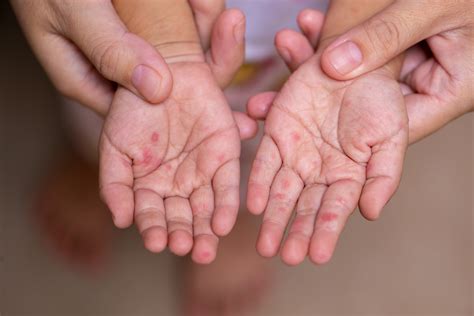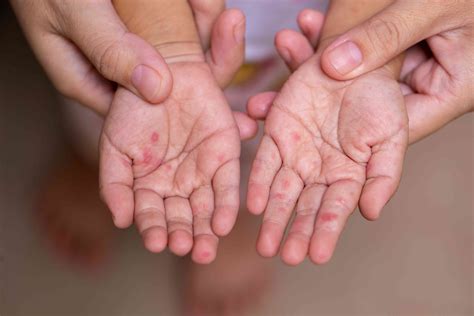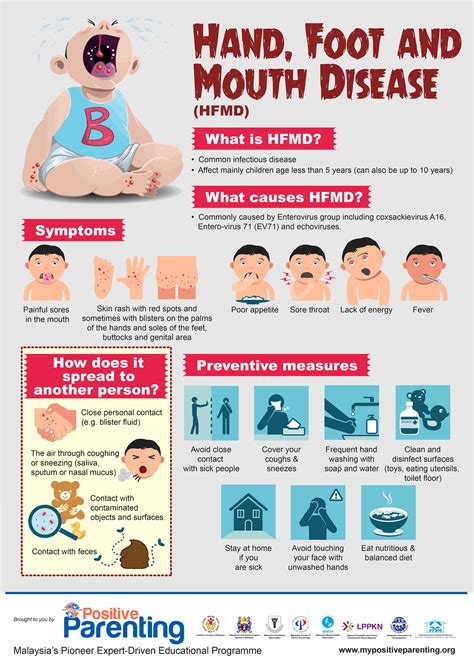Intro
Identify 5 key Hand Foot Mouth symptoms, including rash, fever, and mouth sores, to recognize signs of HFMD, a common viral illness in children, characterized by blisters, ulcers, and skin lesions, and learn about its causes, treatment, and prevention methods.
Hand, foot, and mouth disease (HFMD) is a common viral illness that affects individuals of all ages, but it is most prevalent among children under the age of 5. The disease is characterized by the appearance of sores and rashes on the hands, feet, and mouth, as well as other symptoms such as fever and irritability. Understanding the symptoms of HFMD is crucial for early detection and treatment, which can help alleviate the discomfort and prevent complications. In this article, we will delve into the 5 common hand foot mouth symptoms, their causes, and what you can do to manage them.
The hand, foot, and mouth disease is highly contagious and can spread quickly through direct contact with an infected person, contaminated surfaces, or through the air when an infected person coughs or sneezes. The virus that causes HFMD, usually coxsackievirus A or enterovirus 71, can survive on surfaces for extended periods, making it easy to contract the disease. Recognizing the symptoms early on can help prevent the spread of the disease and reduce the risk of complications.
Hand, foot, and mouth disease can be distressing for both children and adults, especially when it comes to managing the symptoms. The disease can cause significant discomfort, pain, and distress, especially in young children who may not be able to communicate their symptoms effectively. Furthermore, the disease can lead to complications such as dehydration, especially if the person is unable to eat or drink due to the sores in the mouth. Understanding the symptoms and seeking medical attention early on can help prevent these complications and ensure a speedy recovery.
Common Hand Foot Mouth Symptoms

The common hand foot mouth symptoms include:
- Fever: A high temperature, usually above 100.4°F (38°C), is one of the first symptoms of HFMD.
- Sore throat: A sore throat can make it painful to swallow, and it may be accompanied by a fever.
- Rash: A rash or blisters on the hands, feet, and mouth are characteristic of HFMD. The rash can be red, flat, and may blister.
- Mouth sores: Sores in the mouth, also known as oral lesions, can be painful and make it difficult to eat or drink.
- Irritability: Children with HFMD may become irritable and fussy due to the discomfort and pain caused by the symptoms.
Causes of Hand Foot Mouth Disease

The causes of hand, foot, and mouth disease are usually viral, with coxsackievirus A and enterovirus 71 being the most common culprits. These viruses can spread quickly through:
- Direct contact: Touching an infected person, especially if they have open sores or blisters.
- Contaminated surfaces: Touching surfaces that have come into contact with the virus, such as doorknobs, toys, or utensils.
- Airborne transmission: Inhaling the virus when an infected person coughs or sneezes.
Prevention and Treatment
Preventing the spread of hand, foot, and mouth disease is crucial to reducing the risk of complications. Some ways to prevent the spread of the disease include: * Practicing good hygiene: Washing hands frequently with soap and water, especially after using the bathroom, before eating, and after blowing your nose, coughing or sneezing. * Avoiding close contact: Avoiding close contact with individuals who have HFMD, especially if they have open sores or blisters. * Disinfecting surfaces: Disinfecting surfaces and objects that may have come into contact with the virus.Managing Hand Foot Mouth Symptoms

Managing hand, foot, and mouth symptoms can help alleviate the discomfort and prevent complications. Some ways to manage the symptoms include:
- Taking medication: Over-the-counter pain medication, such as acetaminophen or ibuprofen, can help reduce fever and alleviate pain.
- Staying hydrated: Drinking plenty of fluids, such as water, clear broth, or electrolyte-rich beverages, can help prevent dehydration.
- Eating soft foods: Eating soft, bland foods, such as yogurt, mashed bananas, or scrambled eggs, can help reduce discomfort while eating.
Complications of Hand Foot Mouth Disease
While hand, foot, and mouth disease is usually a mild illness, it can lead to complications, especially in young children. Some potential complications include: * Dehydration: Not drinking enough fluids can lead to dehydration, which can be severe if left untreated. * Bacterial superinfections: Bacterial infections can occur if the sores or blisters become infected. * Viral meningitis: In rare cases, HFMD can lead to viral meningitis, a serious infection that requires immediate medical attention.Seeking Medical Attention

Seeking medical attention is crucial if you or your child is experiencing severe symptoms or if you are unsure about the diagnosis. A healthcare professional can:
- Diagnose the condition: A healthcare professional can diagnose HFMD based on the symptoms and physical examination.
- Provide treatment: A healthcare professional can provide guidance on managing the symptoms and preventing complications.
- Monitor for complications: A healthcare professional can monitor for potential complications and provide timely intervention if necessary.
Preventing Future Outbreaks
Preventing future outbreaks of hand, foot, and mouth disease requires ongoing effort and vigilance. Some ways to prevent future outbreaks include: * Practicing good hygiene: Continuing to practice good hygiene, such as washing hands frequently, can help reduce the risk of transmission. * Avoiding close contact: Avoiding close contact with individuals who have HFMD can help reduce the risk of transmission. * Disinfecting surfaces: Disinfecting surfaces and objects regularly can help reduce the risk of transmission.Conclusion and Final Thoughts

In conclusion, hand, foot, and mouth disease is a common viral illness that can cause significant discomfort and distress. Understanding the symptoms, causes, and treatment options is crucial for early detection and management. By practicing good hygiene, avoiding close contact, and disinfecting surfaces, we can reduce the risk of transmission and prevent future outbreaks. If you or your child is experiencing symptoms of HFMD, seek medical attention promptly to ensure timely intervention and prevent complications.
We invite you to share your experiences and thoughts on hand, foot, and mouth disease. Have you or your child ever had HFMD? What were your symptoms, and how did you manage them? Share your story in the comments below, and let's work together to raise awareness about this common viral illness.
What are the common symptoms of hand, foot, and mouth disease?
+The common symptoms of hand, foot, and mouth disease include fever, sore throat, rash, mouth sores, and irritability.
How is hand, foot, and mouth disease transmitted?
+Hand, foot, and mouth disease is transmitted through direct contact with an infected person, contaminated surfaces, or through the air when an infected person coughs or sneezes.
How can I prevent the spread of hand, foot, and mouth disease?
+You can prevent the spread of hand, foot, and mouth disease by practicing good hygiene, avoiding close contact with individuals who have HFMD, and disinfecting surfaces regularly.
What are the potential complications of hand, foot, and mouth disease?
+The potential complications of hand, foot, and mouth disease include dehydration, bacterial superinfections, and viral meningitis.
When should I seek medical attention for hand, foot, and mouth disease?
+You should seek medical attention if you or your child is experiencing severe symptoms, such as high fever, difficulty breathing, or if you are unsure about the diagnosis.
